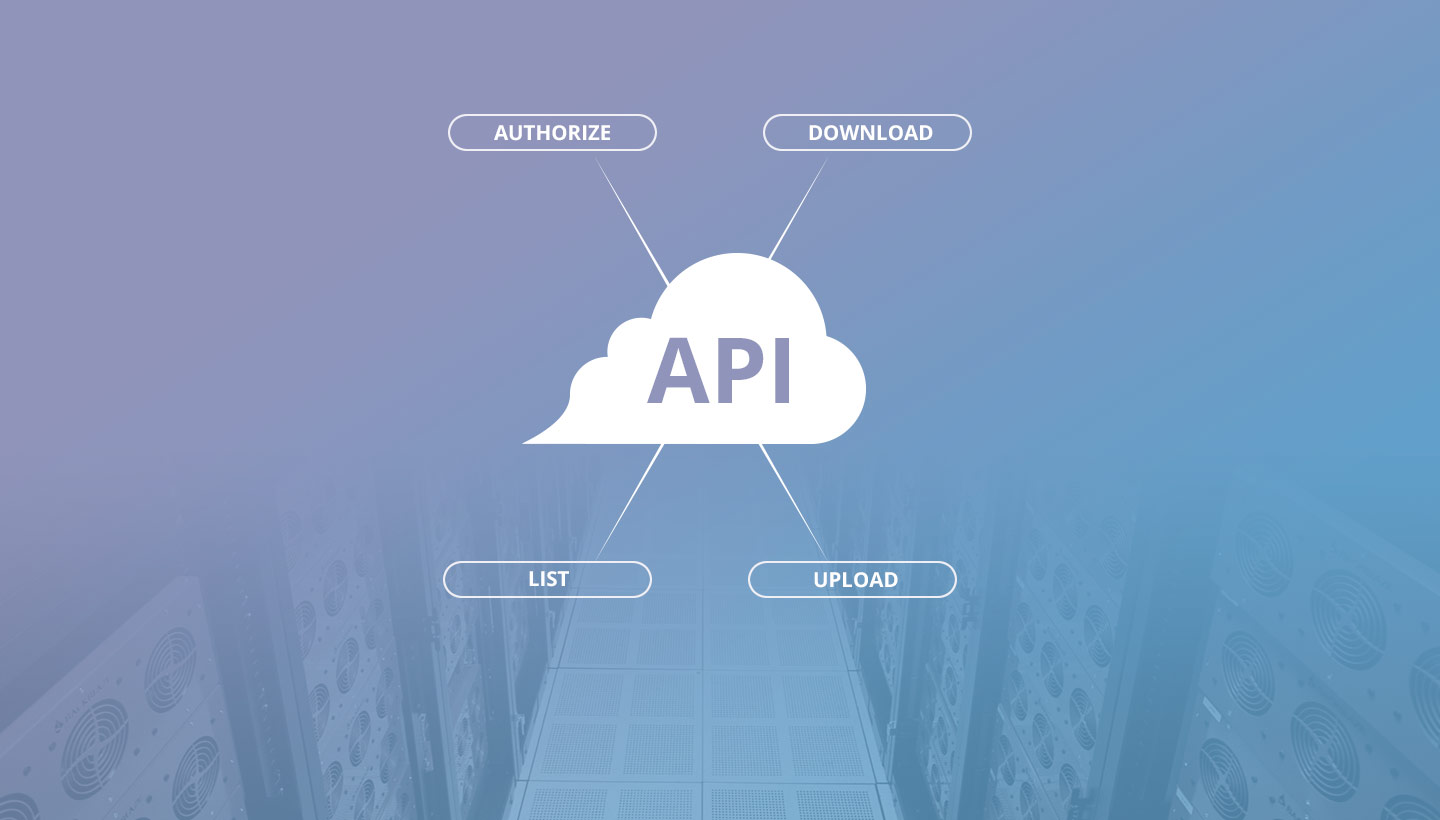
When we get asked, “why did Backblaze make its own set of APIs for B2,” the question behind the question is most often “why didn’t Backblaze just implement an S3-compatible interface for B2?”
Either are totally reasonable questions to ask. The quick answer to either question? So our customers and partners can move faster while simultaneously enabling Backblaze to sustainably offer a cloud storage service that is ¼ of the price of S3.
But, before we jump all the way to the end, let me step you through our thinking.
The Four Major Functions of Cloud Storage APIs
Throughout cloud storage, S3 or otherwise, APIs are meant to mainly provide access to four major underlying functions:
- Authorization — Providing account/bucket/file access
- Upload — Sending files to the cloud
- Download — Data retrieval
- List — Data checking/selection/comparison
The comparison between B2 and S3 on the List and Download functions is, candidly, not that interesting. Fundamentally, we ended up having similar approaches when solving those challenges. If the detail is of interest, I’m happy to get into that on a later post or answer questions in the comments below.
Backblaze and Amazon did take different approaches to how each service handles Authorization. The 5 step approach for S3 is well outlined here. B2’s architecture enables secure authorization in just 2 steps. My assertion is that a 2 step architecture is ~60% simpler than having a 5 step approach. To understand what we’re doing, I’d like to introduce the concept of Backblaze’s “Contract Architecture.”
The easiest way to understand B2’s Contract Architecture is to deep dive into how we handle the Upload process.
Uploads (Load Balancing vs Contract Architecture)
The interface to upload data into Amazon S3 is actually a bit simpler than Backblaze B2’s API. But it comes at a literal cost. It requires Amazon to have a massive and expensive choke point in their network: load balancers. When a customer tries to upload to S3, she is given a single upload URL to use. For instance, http://s3.amazonaws.com/<bucketname>. This is great for the customer as she can just start pushing data to the URL. But that requires Amazon to be able to take that data and then, in a second step behind the scenes, find available storage space and then push that data to that available location. The second step creates a choke point as it requires having high bandwidth load balancers. That, in turn, carries a significant customer implication; load balancers cost significant money.
When we were creating the B2 APIs, we faced a dilemma — do we go a simple but expensive route like S3? Or is there a way to remove significant cost even if it means introducing some slight complexity? We understood that there are perfectly great reasons to go either way — and there are customers at either end of this decision tree.
We realized the expense savings could be significant; we know load balancers well. We use them for our Download capabilities. They are expensive so, to run a sustainable service, we charge for downloads. That B2 download pricing is 1¢/GB while Amazon S3 starts at 9¢/GB is a subject we covered in a prior blog post.
Back to the B2 upload function. With our existing knowledge of the “expensive” design, the next step was to understand the alternative path. We found a way to create significant savings by only introducing a modest level of complexity. Here’s how: When a “client” wants to push data to the servers, it does not just start uploading data to a “well known URL” and have the SERVER figure out where to put the data. At the start, the client contacts a “dispatching server” that has the job of knowing where there is optimally available space in a Backblaze data center.
The dispatching server (the API server answering the b2_get_upload_url call) tells the client “there is space over on “Vault-8329.” This next step is our magic. Armed with the knowledge of the open vault, the client ends its connection with the dispatching server and creates a brand new request DIRECTLY to Vault-8329 (calling b2_upload_file or b2_upload_part). No load balancers involved! This is guaranteed to scale infinitely for very little overhead cost. A side note is that the client can continue to directly call b2_upload_file repeatedly from now on (without asking the dispatching server ever again), up until it gets the response indicating that particular vault is full. In other words, this does NOT double the number of network requests.
The “Contract” concept emanates from a simple truth: all APIs are contracts between two entities (machines). Since the client knows exactly where to go and exactly what authorization to bring with it, it can establish a secure “contract” with the Vault specified by the dispatching server.[1] The modest complexity only comes into play if Vault-8392 fills up, gets too busy, or goes offline. In that case, the client will receive either a 500 or 503 error as notification that the contract has been terminated (in effect, it’s a firm message that says “stop uploading to Vault-8392, it doesn’t have room for more data”). When this happens, the client is responsible to go BACK to the dispatching server, ask for a new vault, and retry the upload to a different vault. In the scenario where the client has to go back to the dispatching server, the “two phase” process becomes more work for the client versus S3’s singular “well known URL” architecture. Of course, this is all handled at the code level and is well documented. In effect, your code just needs to know that “if you receive a 500 block error, just retry.” It’s free, it’s easy, and it will work.
So while the Backblaze approach introduces some modest complexity, it can quickly and easily be reliably handled with code. Looking at S3’s approach, it is certainly simpler, but it results in three expensive consequences:
1) Expensive fixed costs. Amazon S3 has a single upload URL choke point that requires load balancers and extremely high bandwidth requirements. Backblaze’s architecture does not require moving data around internally; this lets us use commodity 10 GB/s connections that are affordable and will scale infinitely. Further, as discussed above, load balancing hardware is expensive. By removing it from our Upload system, we remove a significant cost center.
2) Expensive single URL availability issues. Amazon S3’s solution requires high availability of the single upload URL for massive amounts of data. The Contract concept from Backblaze works more reliably, but does add slight additional complexity when (rare) extra network round trips are needed.
3) Expensive, time consuming data copy needs (and “eventual consistency”). Amazon S3 requires the copying of massive amounts of data from one part of their network (the upload server) to wherever the data’s ultimate resting place will be. This is at the root of one of the biggest frustrations when dealing with S3: Amazon’s “eventual consistency.” It means that you can’t use your data until it has been pushed to all the places it needs to go. As the article notes, this is usually fast, but can be material amounts of time, anytime. The lack of predictability around access times is something anyone dealing with S3 is all too familiar with.
The B2 architecture offers what one could consider “strong consistency.” There are different definitions of that idea. Ours is that the client connects DIRECTLY with the correct final location for the data to land. Once our system has confirmed a write, the data has been written to enough places that we can guarantee that the data can be seen without delay.
Was our decision a good one? Customers will continue to vote on that, but it appears that the marginal complexity is more than offset by the fact that B2 is sustainable service offered at ¼ of S3’s price.
But Seriously, Why Aren’t You Just “S3 Compatible?”
The use of Object Storage requires some sort of interface. You can build it yourself by learning your vendor’s APIs or you can go through a third party integration. Regardless of what route you choose, somebody is becoming fluent in the vendor’s APIs. And beyond the difference in cost, there’s a reliability component.
This is a good time to clear up a common misconception. The S3 protocol is not a specification: it’s an API doc. Why does this matter? Because API docs leave many outcomes undocumented. For instance, when one uses S3’s list_files function, a developer canNOT know what is going to happen just by reading the API docs. Compounding this issue is the sheer scope of the S3 API; it is huge and expanding. Systems that purport to be “S3 compatible” are unlikely to implement the full API and have to document whatever subset they implement. Once that is done, they will have to work with integration partners and customers to communicate what subset they choose as “important.”
Ultimately, we have chosen to create robust documentation describing, among other things, the engineering specification (this input returns that output, here’s how B2 handles various error cases, etc).
With hundreds of integrations from third parties and hundreds of thousands of customers, it’s clear that our APIs have proven easy to implement. The reality is the first time anyone implements cloud storage into their application it can take weeks. The first move into the cloud can be particularly tough for legacy applications. But the marginal cloud implementation can be reliably completed in days, if not hours, if the documentation is clear and the APIs can be well understood. I’m pleased that we’ve been able to create a complete solution that is proving quite easy to use.
And it’s a big deal that B2 is free of the “load balancer problem.” It solves for a huge scaling issue. When we roll out new vaults in new data centers in new countries, the clients are contacting those vaults DIRECTLY (over whatever network path is shortest) and so there are fewer choke points in our architecture.
It all means that, over an infinite time horizon, our customers can rely on B2 as the most affordable, easiest to use cloud storage on the planet. And, at the end of the day, if we’re doing that, we’ve done the right thing.
[1] The Contract Architecture also explains how we got to a secure two step Authorization process. When you call the dispatching server, we run the authentication process and then give you a Vault for uploads and an Auth token. When you are establishing the contract with the Vault, the Auth token is required before any other operation can begin.




